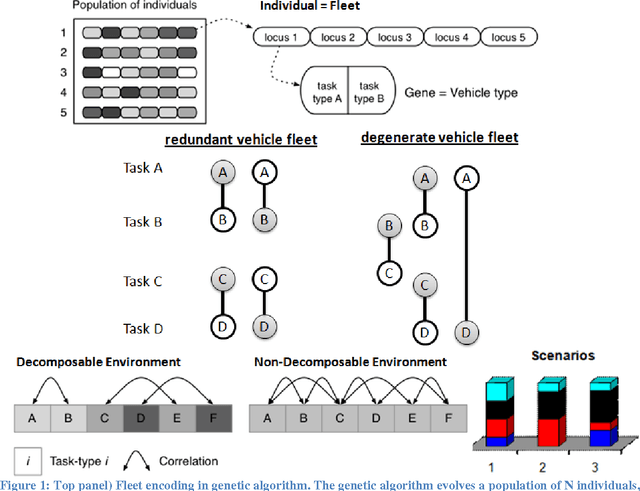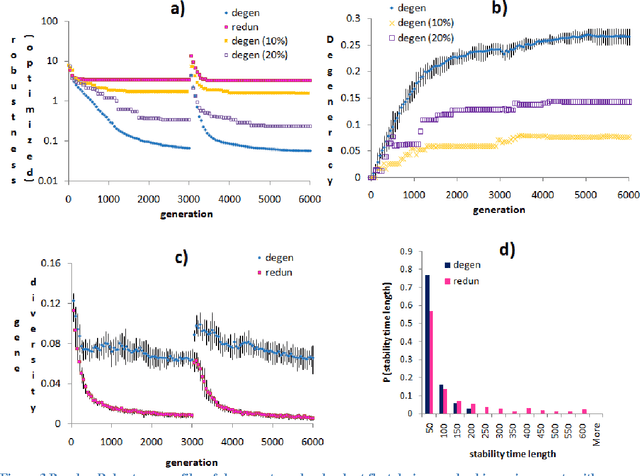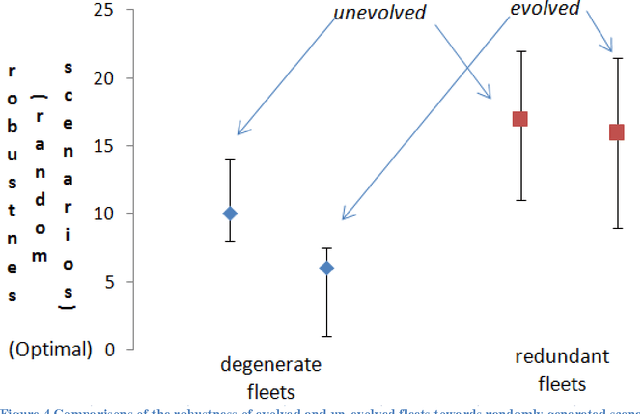James M Whitacre
Evolutionary Mechanics: new engineering principles for the emergence of flexibility in a dynamic and uncertain world
Jan 21, 2011



Abstract:Engineered systems are designed to deftly operate under predetermined conditions yet are notoriously fragile when unexpected perturbations arise. In contrast, biological systems operate in a highly flexible manner; learn quickly adequate responses to novel conditions, and evolve new routines/traits to remain competitive under persistent environmental change. A recent theory on the origins of biological flexibility has proposed that degeneracy - the existence of multi-functional components with partially overlapping functions - is a primary determinant of the robustness and adaptability found in evolved systems. While degeneracy's contribution to biological flexibility is well documented, there has been little investigation of degeneracy design principles for achieving flexibility in systems engineering. Actually, the conditions that can lead to degeneracy are routinely eliminated in engineering design. With the planning of transportation vehicle fleets taken as a case study, this paper reports evidence that degeneracy improves robustness and adaptability of a simulated fleet without incurring costs to efficiency. We find degeneracy dramatically increases robustness of a fleet to unpredicted changes in the environment while it also facilitates robustness to anticipated variations. When we allow a fleet's architecture to be adapted in response to environmental change, we find degeneracy can be selectively acquired, leading to faster rates of design adaptation and ultimately to better designs. Given the range of conditions where favorable short-term and long-term performance outcomes are observed, we propose that degeneracy design principles fundamentally alter the propensity for adaptation and may be useful within several engineering and planning contexts.
Survival of the flexible: explaining the recent dominance of nature-inspired optimization within a rapidly evolving world
Jan 21, 2011



Abstract:Although researchers often comment on the rising popularity of nature-inspired meta-heuristics (NIM), there has been a paucity of data to directly support the claim that NIM are growing in prominence compared to other optimization techniques. This study presents evidence that the use of NIM is not only growing, but indeed appears to have surpassed mathematical optimization techniques (MOT) in several important metrics related to academic research activity (publication frequency) and commercial activity (patenting frequency). Motivated by these findings, this article discusses some of the possible origins of this growing popularity. I review different explanations for NIM popularity and discuss why some of these arguments remain unsatisfying. I argue that a compelling and comprehensive explanation should directly account for the manner in which most NIM success has actually been achieved, e.g. through hybridization and customization to different problem environments. By taking a problem lifecycle perspective, this paper offers a fresh look at the hypothesis that nature-inspired meta-heuristics derive much of their utility from being flexible. I discuss global trends within the business environments where optimization algorithms are applied and I speculate that highly flexible algorithm frameworks could become increasingly popular within our diverse and rapidly changing world.
Computational Scenario-based Capability Planning
Jul 03, 2009Abstract:Scenarios are pen-pictures of plausible futures, used for strategic planning. The aim of this investigation is to expand the horizon of scenario-based planning through computational models that are able to aid the analyst in the planning process. The investigation builds upon the advances of Information and Communication Technology (ICT) to create a novel, flexible and customizable computational capability-based planning methodology that is practical and theoretically sound. We will show how evolutionary computation, in particular evolutionary multi-objective optimization, can play a central role - both as an optimizer and as a source for innovation.
Adaptation and Self-Organization in Evolutionary Algorithms
Jul 03, 2009



Abstract:Abbreviated Abstract: The objective of Evolutionary Computation is to solve practical problems (e.g. optimization, data mining) by simulating the mechanisms of natural evolution. This thesis addresses several topics related to adaptation and self-organization in evolving systems with the overall aims of improving the performance of Evolutionary Algorithms (EA), understanding its relation to natural evolution, and incorporating new mechanisms for mimicking complex biological systems.
Evidence of coevolution in multi-objective evolutionary algorithms
Jul 02, 2009



Abstract:This paper demonstrates that simple yet important characteristics of coevolution can occur in evolutionary algorithms when only a few conditions are met. We find that interaction-based fitness measurements such as fitness (linear) ranking allow for a form of coevolutionary dynamics that is observed when 1) changes are made in what solutions are able to interact during the ranking process and 2) evolution takes place in a multi-objective environment. This research contributes to the study of simulated evolution in a at least two ways. First, it establishes a broader relationship between coevolution and multi-objective optimization than has been previously considered in the literature. Second, it demonstrates that the preconditions for coevolutionary behavior are weaker than previously thought. In particular, our model indicates that direct cooperation or competition between species is not required for coevolution to take place. Moreover, our experiments provide evidence that environmental perturbations can drive coevolutionary processes; a conclusion that mirrors arguments put forth in dual phase evolution theory. In the discussion, we briefly consider how our results may shed light onto this and other recent theories of evolution.
Degenerate neutrality creates evolvable fitness landscapes
Jul 02, 2009



Abstract:Understanding how systems can be designed to be evolvable is fundamental to research in optimization, evolution, and complex systems science. Many researchers have thus recognized the importance of evolvability, i.e. the ability to find new variants of higher fitness, in the fields of biological evolution and evolutionary computation. Recent studies by Ciliberti et al (Proc. Nat. Acad. Sci., 2007) and Wagner (Proc. R. Soc. B., 2008) propose a potentially important link between the robustness and the evolvability of a system. In particular, it has been suggested that robustness may actually lead to the emergence of evolvability. Here we study two design principles, redundancy and degeneracy, for achieving robustness and we show that they have a dramatically different impact on the evolvability of the system. In particular, purely redundant systems are found to have very little evolvability while systems with degeneracy, i.e. distributed robustness, can be orders of magnitude more evolvable. These results offer insights into the general principles for achieving evolvability and may prove to be an important step forward in the pursuit of evolvable representations in evolutionary computation.
 Add to Chrome
Add to Chrome Add to Firefox
Add to Firefox Add to Edge
Add to Edge